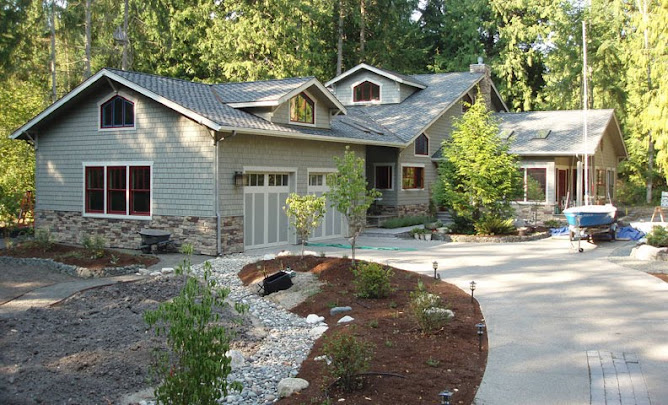We'd considered having Tim Hamm (Castle Rock Landscaping) put in a flagstone patio, but then had second thoughts. The main distraction of a natural rock patio is potential unevenness and weird stuff sprouting up between the small to large gaps between pieces. Secondly, to get nice big thick pieces of rock you have to lay out a small fortune. If set in sand, the rock should be 1-2" thick. Quartzite and other suitable (slatey) rocks go for 20-30¢ per pound ($400-$600/ton), and we were in for a couple tons to do this job. Not to say anything about horsing around several hundred pound pieces.
You can get away with thinner pieces (1/2 - 1") but these should be set in concrete. Well, when you go to the expense of laying a concrete slab, the patio becomes something of a Taj Mahal feature. In the long run we went for Dublin cobble (rounded) pavers from Belgard. They sell all sorts of pavers in a variety of colors. We selected a 3-piece mix: equal numbers of smalls (1/3rds), mediums (2/3rds), and larges (fulls). Each pallet has about 10 layers, each with equal amounts of each size. We ordered 2.5 pallets, enough to do about 275 sq. ft of patio (roughly 11' x 25').
Tim brought the pavers over in a couple
 pallet loads and we off-loaded them at the end of the day after he had finished some other Kala Point work. Since starting on our house last fall, ALL of his work has been in Kala Point or the Vineyards (our old rental subdivision), so this area has turned out to be pretty good for him. To bound the patio on the street side, Tim built another wall, this time around a mounded area (patio island) about 12-18" high. The plan was to plant some large shrubs and smaller rhodies on the island as a visible break from the driveway and street. That way we'll have some added privacy when we're dining or entertaining on the patio.
pallet loads and we off-loaded them at the end of the day after he had finished some other Kala Point work. Since starting on our house last fall, ALL of his work has been in Kala Point or the Vineyards (our old rental subdivision), so this area has turned out to be pretty good for him. To bound the patio on the street side, Tim built another wall, this time around a mounded area (patio island) about 12-18" high. The plan was to plant some large shrubs and smaller rhodies on the island as a visible break from the driveway and street. That way we'll have some added privacy when we're dining or entertaining on the patio.After leveling the patio area (shovel and rake, long board and level), I covered the area with landscape fabric to repel weeds (and blackberries, which come up everywhere) and held it down with large nails. Then Tim and I picked up three cubic yards (7500#) of 1/4" minus crushed basalt. This is everything that passes the 1/4" screen, and its a good base for patios. We wheelbarrowed and raked it into place, then ran a long board across the top to level it in a rough sense.
We rented a plate compactor, which is a vertical vibrator attached to a steel base plate. Fire that baby up and off you go. It really compacts material, and we did the whole patio in about an hour. Another shot at leveling with a long 2x6 board, then a final compaction. We ran out of time that day, but it conveniently rained over the weekend to keep everything in place.

 Today (Mon. 9/27) we started laying pavers like mad men. I'd worked out a 6-paver pattern over the weekend, and printed up some copies for us to work from. In 5 hours we managed to lay 2 whole pallets of pavers (216 sq. ft), move some rocks in the basalt walls back and forth along paver edges, and prepare to cut a couple dozen pavers for irregular margins or where the sewer-line clean out pokes through the patio (can't cover up this important puppy).
Today (Mon. 9/27) we started laying pavers like mad men. I'd worked out a 6-paver pattern over the weekend, and printed up some copies for us to work from. In 5 hours we managed to lay 2 whole pallets of pavers (216 sq. ft), move some rocks in the basalt walls back and forth along paver edges, and prepare to cut a couple dozen pavers for irregular margins or where the sewer-line clean out pokes through the patio (can't cover up this important puppy).We'll need to get some more base rock, the other half pallet of pavers (due next Monday), and form a rounded edge that parallels the rock wall that borders the patio. All in all its going pretty well, about 80% done and just in time for Octoberfest; that would be a perfect way to break it in.
PS (10/5). Tim and I finished up yesterday. We left the gravel walk out, expanded the patio to the rock wall and made cut (curved) edges on the two ends. Looks great, relatively flat and level, and nice and stable. Now we'll hose it down and continue to fill the gaps (tiny) between the pavers with fine sand. This helps to lock the pavers in place.

